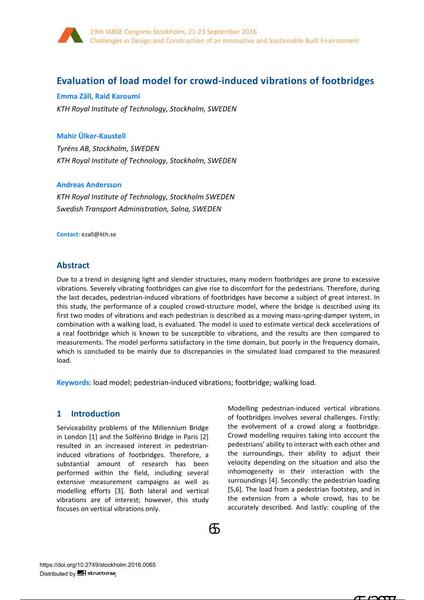Evaluation of load model for crowd-induced vibrations of footbridges

|
|
|||||||||||
Bibliografische Angaben
| Autor(en): |
Emma Zäll
(KTH Royal Institute of Technology, Stockholm, SWEDEN)
Mahir Ülker-Kaustell (Tyréns AB, Stockholm, Sweden) Andreas Andersson Raid Karoumi |
||||
|---|---|---|---|---|---|
| Medium: | Tagungsbeitrag | ||||
| Sprache(n): | Englisch | ||||
| Tagung: | IABSE Congress: Challenges in Design and Construction of an Innovative and Sustainable Built Environment, Stockholm, Sweden, 21-23 September 2016 | ||||
| Veröffentlicht in: | IABSE Congress Stockholm, 2016 | ||||
|
|||||
| Seite(n): | 65-72 | ||||
| Anzahl der Seiten (im PDF): | 8 | ||||
| Jahr: | 2016 | ||||
| DOI: | 10.2749/stockholm.2016.0065 | ||||
| Abstrakt: |
Due to a trend in designing light and slender structures, many modern footbridges are prone to excessive vibrations. Severely vibrating footbridges can give rise to discomfort for the pedestrians. Therefore, during the last decades, pedestrian-induced vibrations of footbridges have become a subject of great interest. In this study, the performance of a coupled crowd-structure model, where the bridge is described using its first two modes of vibrations and each pedestrian is described as a moving mass-spring-damper system, in combination with a walking load, is evaluated. The model is used to estimate vertical deck accelerations of a real footbridge which is known to be susceptible to vibrations, and the results are then compared to measurements. The model performs satisfactory in the time domain, but poorly in the frequency domain, which is concluded to be mainly due to discrepancies in the simulated load compared to the measured load. |
||||
| Stichwörter: |
Fußgängersteg Fußgängerbrücke Lastmodell
|
||||

